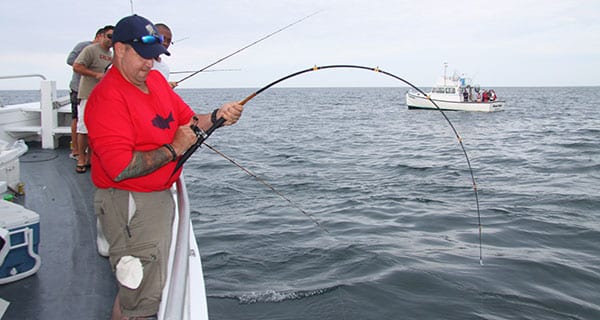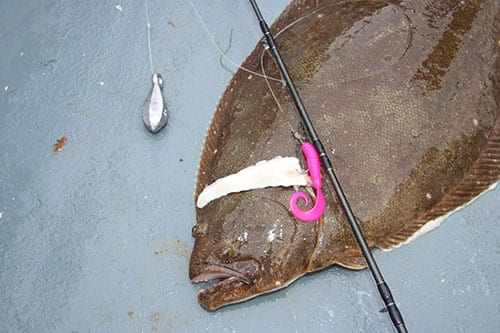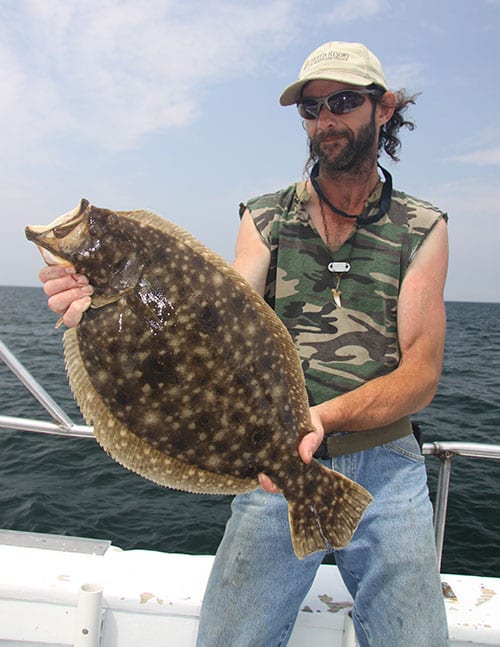
By Tom Schlichter
No matter where you fish in the Northeast, fluke regulations are a little on the tight side. With a large minimum sizes and low creel limits, catching a few isn’t really a problem. Catching enough that are big enough to legally bring home for dinner, well, that can sometimes be a very different story.
Also known as summer flounder, fluke are the major draw for Long Island’s summertime bottom-fishing fans and a favorite out of Connecticut and Rhode Island anglers as well. Because word gets out fast when a solid bite of decent fish beaks out, fishing pressure can be intense in the better-known hot spots, resulting in the “keepers” being culled rather quickly. That means if you want to keep taking home dinner, you’ll need to move around a bit, try new areas and, perhaps, experiment with a few new approaches to tempt those bigger fish that manage to slip through the fleet.
CHOOSE QUALITY OVER QUANTITY
The starting point to catching more keeper fluke is the decision to target bigger fish at the expense of faster-paced action with smaller ones. Using larger baits is one way to entice big fluke while discouraging the small guys from biting. The adage “big baits for big fish” certainly applies in fluke fishing and making the switch doesn’t have to be difficult.
Begin by cutting longer strips of squid or fish for bait. Instead of the traditional three- or four-inch long pennant of squid, use six- to eight-inch long strips cut to measure no more than half-an-inch wide. Slice the last two inches of the strip at the narrow end to create a split-tail that will flutter enticingly in the current. Hook these strips once in the wide end so they ride straight out behind the bend of the hook. Sliced sea robin, mackerel and bluefish strips work as well or even better than squid once the season starts rolling. Berkley Gulp! Swimming Minnows work well, too, although they seem to catch a little better as the season advances in to early June.
If you want to tip your strip bait with little something extra, shun the standard spearing, sand eel or live killie and opt for larger, frozen smelt. For those planning on using bucktails, forget the small profile half-ounce size and tie on something outlandish like an eight-inch red or white jelly worm impaled on a three-quarter to one-ounce leadhead or bucktail jig or a six-inch Berkley Gulp! saltwater grub with a nuclear chicken color pattern.
FISH DEEP AND PROBE STRUCTURE

Big fish like big water and this rule finds fluke to be no exception. Look for the deeper channels leading to inlets and harbor mouths to hold the biggest summer flatties. Instead of drifting casually across back-bay flats in four to six feet of water, target areas with eight feet or more under your hull. What you need to find in this instance is an area where the water looks rich green or blue. On a clear day, the bottom should still be well out of sight, providing shade and production to big fish holding in the sand.
Structure is also key when it comes to finding the biggest fluke. Bridge pilings, bulkheads, rotting docks, jetty walls, artificial reefs, boulder-strewn bottom and sunken debris are all attractive to doormats. Just about any form of structure in deep water will hold a few resident fluke of keeper proportions. Unlike small fluke, which are willing to expend plenty of energy to feed and thus will hug bottom in even the strongest of currents, big fluke like to lie in the lee of underwater obstructions and wait opportunistically for bergalls, small blackfish, sea bass, porgies, snappers and the like to carelessly swim past.
How do you interest these big fluke? Fish tight to the structure, trying to keep your line within five yards of the snags at all times. Probe these areas during periods of light currents – during the first and last hour of a tide, for example. It also helps to work these pieces when the wind is calm, as you can stay right alongside the structure for a longer period of time. If the structure is outside of a navigation channel, consider anchoring-up and working your bait diligently around the perimeter. You won’t catch many fluke fishing this way, but you’ll get to take home just about any fish you hook and manage to wrestle into the boat.
GET OFFSHORE

Continuing on the deep water/big fish theme, there are a large percentage of big fluke that choose to remain in the ocean and open Long Island Sound, never entering bay or harbor waters. The cool waters of the Atlantic along the South Shore of Long Island and in the rips around Block Island, and the deep waters bordering points or ledges in Long Island Sound, offer a great opportunity to gather a full limit of fluke you can be proud about. Look for the most consistent action to take place in 30 to 50-foot depths during May and early June. From Father’s Day through Independence Day, the big fish action may shift toward 20-foot depths for a while, but it will certainly slide back out to deeper water as temperatures continue to warm come mid-July.
Of course, if you plan to run outside the bays and harbors, be sure to pick your days carefully. Ocean and open Long Island Sound waves kick up faster and larger than bay and harbor waters. Be aware, too, that inlets can get rough on a tide change, making it difficult to come back inside once you’ve gotten out into more open waters. While fluking on the outside offers great potential, discretion is the better part of valor.
BEEF UP YOUR GEAR
I used to love to use light tackle for fluke fishing, but it is no longer a practical choice if creeling your limit is the prime concern. With the bigger fish in deeper water or around structure, more sinker weight is needed to hold bottom. Put aside the eight-pound-class spinning sticks and opt for a conventional set-up spooled with 15- to 20-pound test line. Choose a fairly stiff rod with a tip that can handle three to six ounces of sinker weight and expect to need even more lead when fishing around full- or new-moon tides. Spool-up your conventional rod with braid for this fishing as the thin diameter of these lines will let you hold bottom with significantly less weight than is needed with monofilament lines. The new KastKing KastPro is a good choice. It’s smooth, strong, super sensitive and abrasion resistant. The 40-pound test should be all you need.
Remember, you aren’t going to have as many hook-ups when targeting big fluke as you will when mixing it up with the shorts. Thus, you need to take advantage of every strike. A stiff set-up will allow you to set the hook with leverage in deeper water, feel the bottom in strong currents, and handle the power of a doormat if you are lucky enough to tie into something special. Beef up, be ready, and hit the water come opening day.









